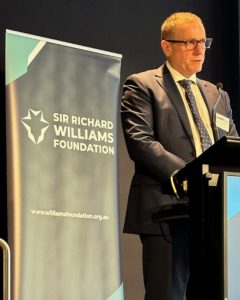Shaping a Way Ahead for Australian Maritime Strategy
The Williams Foundation Seminar held on April 11, 2024 focused on how multi-domain operations could enable Australia to more effectively execute an effective Australian maritime strategy.
But such a discussion pre-supposes that Australia has a maritime strategy and a fairly clear sense of what its maritime interests are which need to be protected. The government’s Defence Strategic Review last year and the recently released defence strategy certainly highlights a range of maritime capabilities which the government has focused upon to determine how best to enhance Australian defence.
But what are the tools in place and the new tools which need to be acquired to enhance Australian maritime security and defence?
Or in other words, there are prior questions to the question of acquiring new ships.
What are the threats? How to organize for them? Who should be responsible for dealing with them? And how to deal with them most effectively with what means?
The government has highlighted a central focus on a strategy of deterrence by denial. But if the Chinese seriously disrupt Australia’s ability to move goods by sea, who is denying whom?
At the seminar, two presentations directly dealt with the questions of maritime strategy and security. The presentation Jennifer Parker of the National Security College of the Australian National University addressed the question of whether Australia actually has a maritime strategy and if they did what was it? The second was by the Commissioner of the Australian Border Force, Michael Outram, and dealt with the very significant question of the daunting challenges to maritime security in a period of disruption of the “rules-based” order.
Parker provided a broad stroke analysis of maritime strategy, rather than reducing the discussion to what platforms and capability which Australia has to operate in the maritime domain. In her presentation she defined maritime strategy for Australia as “the plan to protect Australia’s maritime strategic interests using all aspects of national power.”

Her perspective meant that she would conclude that a maritime strategy defined as deterrence by denial would be too narrow to capture the full spectrum of demands from the maritime domain that required an appropriate security and defense regime to determine and defend Australian maritime interests.
She mentioned several cases of conflicts in the maritime domain which have been evident in the recent past which illustrate the broad nature of the challenges to be dealt with.
One was the targeting of shipping to send a political message which is evident in what is going on in the Middle East. Given Australia’s dependence on maritime trade, this is a problem which Australia clearly needs to be prepared for.
The second has been evident in both the confrontation in the Black Sea and the challenges being addressed by the Nordics and the Baltic states involving the Russians and the Baltic Sea. This is a question of port security and undersea cable protection. Here one is talking about active measures for security and defense, not simply posturing for deterrence.
The third has been the importance of “information war” in the maritime domain evident in the Chinese anything but gray zone confrontation with the Philippines. The Philippines are pulling the strings on their alliance relationships to generate defence options, but they have used transparency to fight back in the information war with the Chinese.
It is also the case that they are adding new defence capabilities which will allow them to counter directly Chinese aggression which again is not building a posture for deterrence by denial – it is about directly confronting the adversary, which has been a major failure, in my view, of characterizing the Chinese as operating the gray zoos.
In a book review I wrote about a book dealing with China and the gray zone, I underscored the limitations of using this concept from the standpoint of shaping credible action policy:
This is how I highlighted the challenge:
“Western analysts have coined phrases like hybrid war and gray zones as a way to describe peer conflict below the level of general armed conflict. But such language creates a cottage industry of think tank analysts, rather than accurately portraying the international security environment.
“Peer conflict notably between the liberal democracies and the 21st century authoritarian powers is conflict over global dominance and management. It is not about managing the global commons; it is about whose rules dominate and apply. Rather than being hybrid or gray, these conflicts, like most grand strategy since Napoleon, are much more about “non war” than they are about war. They shape the rules of the game to give one side usable advantage. They exploit the risk of moving to a higher intensity of confrontation.
“What limits should be crossed to manipulate the risk of going to a higher intensity of competition?”
In our period of history, no credible defence approach can be designed without a strong security foundation. It is not simply about the point of the spear, or the forces generated in a force design for the professional military. It is about having a society and economy built on solid foundation of security.
The presentation of the Commissioner of the Australian Border Force provided a broad understanding of the need for a robust security policy to underwrite a credible maritime strategy. Michael Outram highlighted the importance of Australia’s maritime domain citing its $1 trillion in annual trade and 5% of GDP.

He underscored that there are wide ranging security threats in maritime domain which include illegal fishing, cyberattacks, and biosecurity risks. The challenges of maritime security in the Indo-Pacific region, include the resilience and agility of criminal networks and the limitations of publicly accountable bureaucracies. To deal with these challenges. the Australian Border Force (ABF) is collaborating with Pacific island nations to build capacity and address growing criminal threats, including illegal fishing and migration.
The Australian Border Force (ABF) and Defence have an overlap in their missions, particularly in the maritime domain, but this overlap is not static and can shift depending on circumstances. The Maritime Border Command within ABF working with defence focus on the challenge or surveilling and monitoring vessels operating in Australia’s maritime domain.
In my own view, there is a significant opportunity to leverage autonomous systems into an integrated security and defence operational culture which will be critical in order to be able to deal with the larger issues which Parker highlighted.
The Commissioner went on to argue that the time was ripe for from serious rethinking about how the Australia government needs to work in this area.
He identified several areas where progress needs to be made:
- Consider developing a new civil maritime security strategy that addresses strategic coherence, governance, funding structures, and the definition and scope of civil maritime security in light of changing geopolitical and technological conditions.
- Conduct a series of future focused scenario-based planning exercises to evaluate whether the current operating model or an alternative model such as an independent Coast Guard could be more effective in addressing strategic shifts over the next decade.
- Give serious thought to whether the regional security situation, shifts in technology, and other factors require a different strategic approach to civil maritime security and a redefining of the scope of operations.
- Determine if the current civil maritime strategic architecture, planning, governance, funding, and structure remains fit for purpose over the next decade.
- Assess if the civil maritime operating model of the past 20 years can be sustained and remains fit for the strategic purpose over the next 20 years.
He concluded with the importance of addressing long-term structural funding issues to maintain a fit for purpose civil maritime capability appropriate to Australia’s interests.
The two presentations taken together underscore the need to focus on how the Australian government is organized to address maritime security and defence issues. And I would argue that to use new technologies in this domain is also required fundamental organizational change as well.
The featured graphic is from Jennifer Parker’s brief at the seminar and highlights the maritime supply chain, the security of which is beyond what one might consider is not covered easily by a focus on deterrence by denial.

